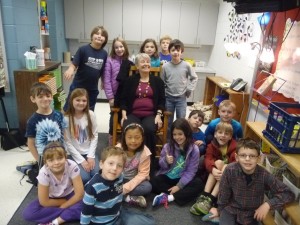“Ooh! I have an idea!,” one boy with expressive brown eyes said, as his third grade classmates waved their hands, eager to get their own ideas out and up on the board as options for a story we would begin writing together.
I was at a local elementary schools where student teacher, Kassandra Hoffmeister, had invited me to come and talk to her class about writing. She had been told by another student teacher, Yarden Batson, about my visit with her class just a few weeks earlier.
I had met Yarden, earlier when I was looking for a house sitter. She came highly recommended and when she found out that I was a writer, with a Bachelor of Science in Elementary Education, she asked if I’d visit her classroom to talk with the kids about writing. Having been away from a classroom setting for what seems like hundreds of years, I eagerly said yes. Not only did I want to step back in time a bit, I’d been concerned that students aren’t given much of a chance to write creatively these days. I thought going into the classroom to inspire kids to write would be a great way to give back to the world of creativity that I have been blessed being a part of.
When someone discovers that I am an artist as well as a writer, they often say, “I don’t have a creative bone in their body.” In response, I jump on my soapbox and try to convince them that they most likely haven’t given themselves a chance.
Creativity isn’t just for those who want to dance, paint, compose music, or write poetry. Everyone is blessed with “creative bones.” Those bones just need to be nurtured.
Creative thinkers rule the world even in science and math departments. Without the ability to step outside of the box, Steve Jobs would never have come up with the computer I’m using to write this blog post. Alexander Graham Bell wouldn’t have invented the telephone, which now is something we all carry around in our pockets. Even the process of designing and constructing an environmentally friendly buildings is a creative act that gets those involved asking questions that no one has pondered before.
The easiest way to nurture creative thinking is to start early. A toddler’s first crayons help him or her to discover the world of color as they move their hands, spreading red, yellow and blue onto a piece of paper. Each piece of paper is the masterpiece of a young mind that hasn’t been strangled by the rule that one must color within the lines.
On my first visit to a third grade classroom, I took a cue from my husband, Bill, an actor, director, and a playwright. I used a story telling exercise he often uses with a newly assembled cast to help them get comfortable with each other and their new roles.
First, I helped the kids create a list of characters they felt drawn to tell a story about. We then worked on a list of settings in which a character might be found. The third list was made up of things the character wants or needs. The fun continues as the children vote on which character the story should be about, where the story is taking place, and the problem the character needs to solve. Sometimes other characters and settings are included as the story takes shape.
In the first class I worked with, the kids began developing a story about a young elephant visiting a football stadium, in hopes of being gifted with his favorite player’s jersey. Yesterday’s class came up with a California Sea Otter, named Jason, who found himself in a portal to the ancient world, where he hoped to find some cotton candy. We can laugh all we want at what seems like a crazy combination of story parts, but these kids are amazing at coming up with story lines that somehow make sense and that gets them started on a path that just might help them one day become creative geniuses.
At the end of my time with them, they’ve not only started the writing process, but we’ve usually had time to talk a little bit about titles, the structure of a paragraph, and the concept of the beginning, the middle and the end of their story. Later in the afternoon after I’m gone, each child finishes writing their own version of the story they started creating together.
What I find to be so much fun, is their enthusiasm and their willingness to leave what makes sense behind, as they jump freely into a world where they can be who they are and need to be. We older, stuck folks could learn a lot from watching them.
I believe that when a teacher stands in front of a classroom of children, the teacher becomes the student, as he or she has the opportunity to be introduced back into a world of creative being, that we too often leave behind as we get older and learned to color within the lines.

